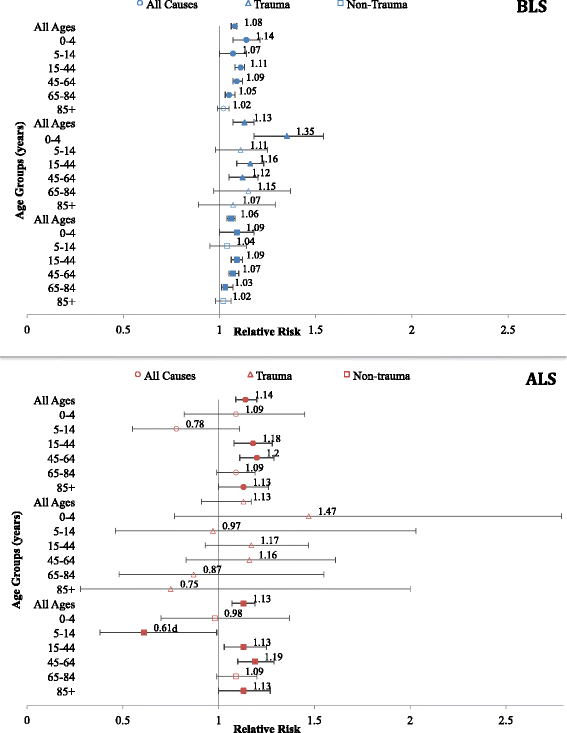Impacts of extreme heat on emergency medical service calls in King County, Washington, 2007-2012: relative risk and time series analyses of basic and advanced life support
- PMID: 26823080
- PMCID: PMC4730772
- DOI: 10.1186/s12940-016-0109-0
Impacts of extreme heat on emergency medical service calls in King County, Washington, 2007-2012: relative risk and time series analyses of basic and advanced life support
Abstract
Background: Exposure to excessive heat kills more people than any other weather-related phenomenon, aggravates chronic diseases, and causes direct heat illness. Strong associations between extreme heat and health have been identified through increased mortality and hospitalizations and there is growing evidence demonstrating increased emergency department visits and demand for emergency medical services (EMS). The purpose of this study is to build on an existing regional assessment of mortality and hospitalizations by analyzing EMS demand associated with extreme heat, using calls as a health metric, in King County, Washington (WA), for a 6-year period.
Methods: Relative-risk and time series analyses were used to characterize the association between heat and EMS calls for May 1 through September 30 of each year for 2007-2012. Two EMS categories, basic life support (BLS) and advanced life support (ALS), were analyzed for the effects of heat on health outcomes and transportation volume, stratified by age. Extreme heat was model-derived as the 95th (29.7 °C) and 99th (36.7 °C) percentile of average county-wide maximum daily humidex for BLS and ALS calls respectively.
Results: Relative-risk analyses revealed an 8 % (95 % CI: 6-9 %) increase in BLS calls, and a 14 % (95 % CI: 9-20 %) increase in ALS calls, on a heat day (29.7 and 36.7 °C humidex, respectively) versus a non-heat day for all ages, all causes. Time series analyses found a 6.6 % increase in BLS calls, and a 3.8 % increase in ALS calls, per unit-humidex increase above the optimum threshold, 40.7 and 39.7 °C humidex respectively. Increases in "no" and "any" transportation were found in both relative risk and time series analyses. Analysis by age category identified significant results for all age groups, with the 15-44 and 45-64 year old age groups showing some of the highest and most frequent increases across health conditions. Multiple specific health conditions were associated with increased risk of an EMS call including abdominal/genito-urinary, alcohol/drug, anaphylaxis/allergy, cardiovascular, metabolic/endocrine, diabetes, neurological, heat illness and dehydration, and psychological conditions.
Conclusions: Extreme heat increases the risk of EMS calls in King County, WA, with effects demonstrated in relatively younger populations and more health conditions than those identified in previous analyses.
Figures

Similar articles
-
Association of ambient extreme heat with pediatric morbidity: a scoping review.Int J Biometeorol. 2022 Aug;66(8):1683-1698. doi: 10.1007/s00484-022-02310-5. Epub 2022 Jun 25. Int J Biometeorol. 2022. PMID: 35751701 Free PMC article.
-
A Geographical Analysis of Emergency Medical Service Calls and Extreme Heat in King County, WA, USA (2007-2012).Int J Environ Res Public Health. 2017 Aug 20;14(8):937. doi: 10.3390/ijerph14080937. Int J Environ Res Public Health. 2017. PMID: 28825639 Free PMC article.
-
Increased hospital admissions associated with extreme-heat exposure in King County, Washington, 1990-2010.Rev Environ Health. 2015;30(1):51-64. doi: 10.1515/reveh-2014-0050. Rev Environ Health. 2015. PMID: 25719287 Free PMC article.
-
Increased mortality associated with extreme-heat exposure in King County, Washington, 1980-2010.Int J Biometeorol. 2016 Jan;60(1):85-98. doi: 10.1007/s00484-015-1007-9. Epub 2015 May 10. Int J Biometeorol. 2016. PMID: 25956805 Free PMC article.
-
Heat, Human Performance, and Occupational Health: A Key Issue for the Assessment of Global Climate Change Impacts.Annu Rev Public Health. 2016;37:97-112. doi: 10.1146/annurev-publhealth-032315-021740. Epub 2016 Jan 21. Annu Rev Public Health. 2016. PMID: 26989826 Review.
Cited by
-
Effects of high ambient temperature on ambulance dispatches in different age groups in Fukuoka, Japan.Glob Health Action. 2018;11(1):1437882. doi: 10.1080/16549716.2018.1437882. Glob Health Action. 2018. PMID: 29471745 Free PMC article.
-
The Influence of Heat on Daily Police, Medical, and Fire Dispatches in Boston, Massachusetts: Relative Risk and Time-Series Analyses.Am J Public Health. 2020 May;110(5):662-668. doi: 10.2105/AJPH.2019.305563. Epub 2020 Mar 19. Am J Public Health. 2020. PMID: 32191522 Free PMC article.
-
Just Plain Hot: Examining Summer Daily High Heat Indices and Community-Level Social Vulnerability on Emergency Medical Services On-Scene Responses in San Antonio, Texas, 2015-2018.Cureus. 2023 Jun 3;15(6):e39914. doi: 10.7759/cureus.39914. eCollection 2023 Jun. Cureus. 2023. PMID: 37404445 Free PMC article.
-
Association of ambient extreme heat with pediatric morbidity: a scoping review.Int J Biometeorol. 2022 Aug;66(8):1683-1698. doi: 10.1007/s00484-022-02310-5. Epub 2022 Jun 25. Int J Biometeorol. 2022. PMID: 35751701 Free PMC article.
-
A Geographical Analysis of Emergency Medical Service Calls and Extreme Heat in King County, WA, USA (2007-2012).Int J Environ Res Public Health. 2017 Aug 20;14(8):937. doi: 10.3390/ijerph14080937. Int J Environ Res Public Health. 2017. PMID: 28825639 Free PMC article.
References
-
- CDC, Climate and Health Program. 2010. Retrieved May 30, 2013, from http://www.cdc.gov/climateandhealth/effects/default.htm.
-
- Medina-Ramón M, Zanobetti A, Cavanagh DP, Schwartz J. Extreme temperatures and mortality: assessing effect modification by personal characteristics and specific cause of death in a multi-city case-only analysis. Environ Health Perspect. 2006;114:1331–1336. doi: 10.1289/ehp.9074. - DOI - PMC - PubMed
Publication types
MeSH terms
LinkOut - more resources
Full Text Sources
Other Literature Sources
Medical
Miscellaneous

